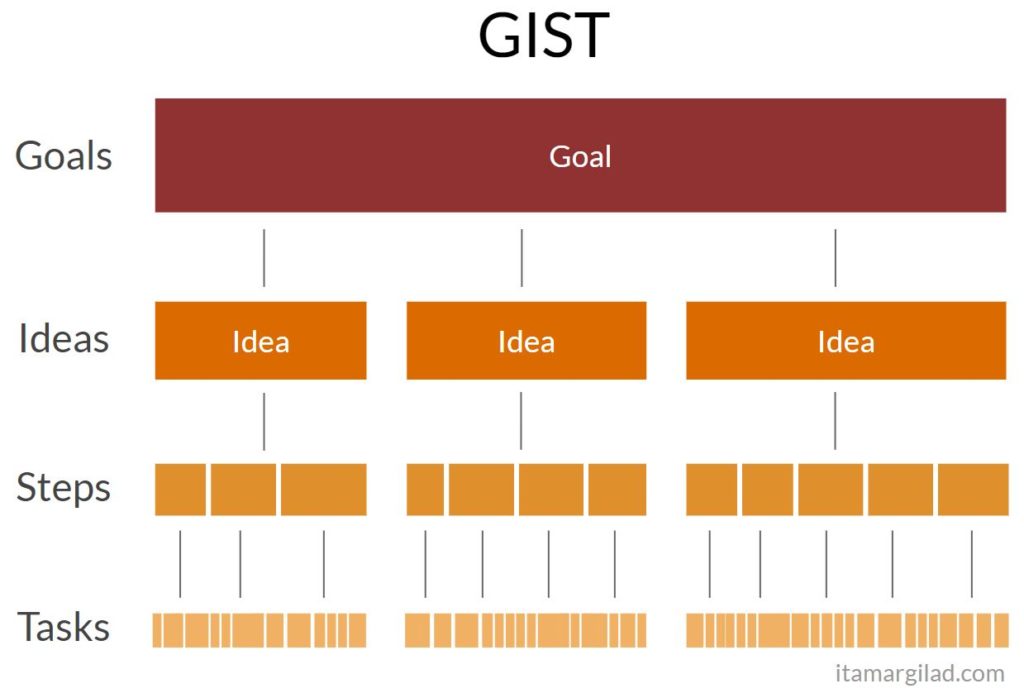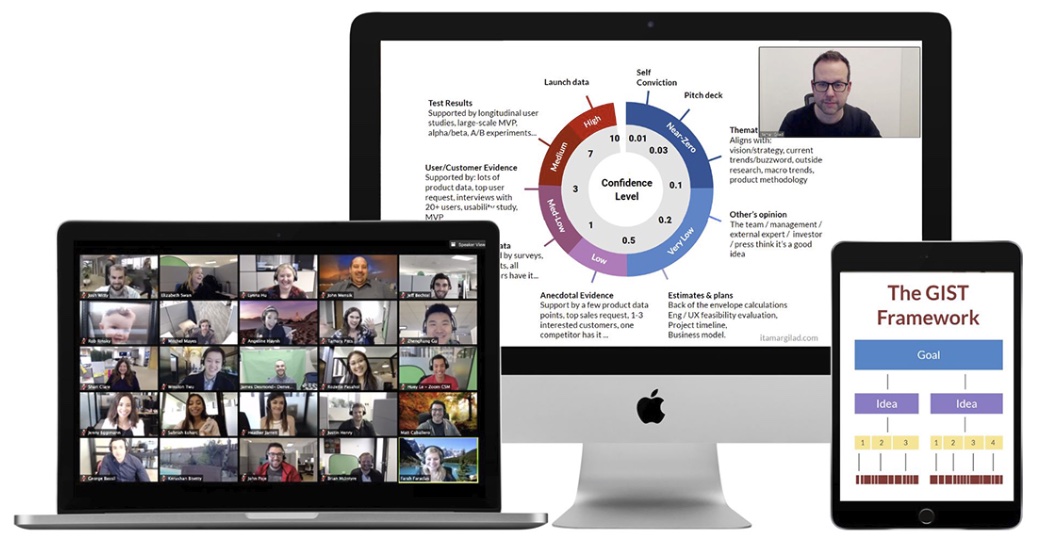On Feb 1st 2018 I published my most viral article. Originally shared on Medium and LinkedIn, it got hundreds of thousands of reads, and was liked and shared in a volume I haven’t seen before or since. It’s still my most popular article,
What was all the fuss about? In this article I first shared the GIST model: Goals, Ideas, Steps and Tasks. GIST explains how to develop products according to the principles of customer-focus, adaptive planning, evidence-guided decisions, and team empowerment. It’s a framework I started envisioning at Google, and later used to help my clients.

While the GIST model includes a lot of existing ideas, it seemed to resonate strongly with the product community. I started getting requests for further articles, talks, and workshops, which to me felt like early signs of product/market fit. Pretty soon GIST became the core of my teachings and over time I added more detail with Metric Trees, the Confidence Meter, the AFTER model, and the GIST Board . With that GIST became an actionable system that quite a few companies started using, many solely based on my articles.
The Big-Bet Project: Writing a Book
The natural next step was to write a book. I started writing in March 2019 with the aim of publishing 12-18 months later. This seemed realistic. After all, I was teaching GIST and helping implement it almost daily, and I’ve written about it extensively. It’s just a matter of putting what I know into a book, right?
As you probably guessed, I fell prey to the classic planning fallacy — grossly underestimating the task ahead of me. Explaining concepts in long-form text is very different from explaining them in a talk or an article. You need to keep readers informed, yet engaged. You have to balance detail with flow. There’s a lot of writing, rewriting, and then yet more rewriting. As a first-time author trying to cover some very big topics, I struggled massively. The 2020 pandemic certainly didn’t help.
Finally after a long and hard slog I completed the first version of the book and invited beta-readers to test it. The feedback was sobering (isn’t it always?) People found useful information in the book, but things were a little too theoretical. It turned out that people mostly knew the theory, or didn’t find it helpful. What they needed were solutions to tough challenges like these:
- How to get an output-focused manager to adopt outcome goals?
- My team doesn’t care about users or the business, they just want to code.
- We do quarterly/yearly roadmaps. Can GIST still work?
- We’re a B2B selling to large enterprises; what should I do about must-have sales requests?
- I’m too busy supporting my team to do research or proper idea prioritization
- We’re missing the infrastructure and knowhow to experiment
- We have many dependencies on other teams
This feedback surfaced a major value gap in my book. I tried to write a product book, yet avoided addressing the giant elephant in the room.
The State of Product Development In the 2020s
In the past 20+ years we have seen a major rethinking of product development. Methodologies like Design Thinking, Lean Startup, and Product discovery (as well many others) upended classic product development and with more scientific-method-like, iterative approaches. Not surprisingly these new methodologies caught on strongly and saw wide adoption. However in many companies they ran into strong friction with classic management approaches. Here are some of the more common ideological conflicts:
- Top-down management vs. empowerment
- Outputs vs. on outcomes
- Plan-and-execute vs. Discovery-and-Delivery
- Sales-focus vs. Customer-focus
- Siloing vs. Shared mission and goals
The result is companies that struggle to adopt modern product development. Many get stuck half way between the old and the new, or find creative ways to subvert the processes. Many product people have become disillusioned and came to the conclusions that the theory and methods offered in the books does not apply in their case. The challenges I listed above all stem from this core problem. There’s a lot of confusion; people know they’re doing things wrong, but what is the right way in their type of company? An indication of the size of the problem is the number of product books, product workshops, product consultants, and product conferences out there. Everyone’s looking for a solution.
Pivoting My Book
This realization left me with a dilemma. The approaches I teach are pretty out there in terms of replacing the old ways with the new. For example I advise getting rid of output roadmaps and output optimization altogether. Should I respond to the call of the market to write a softened version of GIST? This question went right to the heart of what impact I was trying to create with the book. Is it to please readers and sell as many copies as possible? Or Is it to create a meaningful change?
My decision was to stay true to what I believe in. In reality all companies face some of the conflicts I mentioned above, but some find ways to make it work without necessarily undergoing a massive cultural transformation. I’ve also seen too many watered-down processes that help no one. So I kept the book centered on a pragmatic system that may not be easy to adopt, but that will pay massive dividends for those that do.
But, based on feedback of my readers, I did make some major changes to the book:
- I cut a lot of theory out and added more actionable advice showing how things could work in a real-world company. No two companies are exactly the same, so I try to caution that this is just one way of doing things (process is brittle, which is why so many books try to avoid it)
- I glossed over the things everyone knows, and added more of the sticky bits. For example how to deal with a manager that gives you output goals, or why prioritizing by ICE scores so often doesn’t work.
- I wrote more about adoption. In fact the last chapter of the book is devoted just to this topic — what objections you will face, and how you can smooth the adoption curve and improve the odds of success.
- I try to explain how to break the walls between managers and teams, and between the disciplines: engineering, product management, design, and business teams. This is not a battle between good and evil as we like to romanticize. The solution comes from partnership rather than finger-pointing.
But the biggest pivot I made was to change the focus of the book. The earlier versions were centered on the mechanics of the GIST model. But I realized there was yet a bigger thing I could teach that would help with the core problem — Evidence-Guided product development.
At Google and in many other companies I observed that even an hierarchical and siloed organization can do the right things when decision-making is augmented with evidence. Evidence-guided companies see the value in research and experimentation and get why the work has to be distributed (managers don’t have the time to collect evidence). They spend less time on planning and are more likely to focus on outcomes. Evidence is the great equalizer — armed with evidence even a junior person can challenge the opinion of a senior manager (without losing her job). Product teams that use evidence are more likely to be trusted by managers and stakeholders. There’s no wonder that evidence plays such a pivotal role in science, medicine and law, areas where we know that opinions are simply not good enough. It’s time we make it a key ingredient of product development as well.
So Evidence-Guided is the new theme of the book:

Evidence-Guided: Creating High Impact Products in the Face of Uncertainty
(temp cover)
The book still teaches the GIST model, but from the perspective of moving your organization towards Evidence-Guided thinking. Chapter 6, The Evidence-Guided Company, gives a full example of that means, including strategy, roadmaps, and org structure. The main protagonist of the story is you, the product person or manager who wishes to create a positive change.
What’s Next?
My planned 12-18 months book project is well into its fifth year, but finally there’s an end in sight. The book is now in final editing, and I aim to publish it this September (2023).
If you’re interested in reading some or all of it earlier, join my newsletter. My community is going to get first dibs on preview chapters and pre-release versions. If you just want to be notified when the book is officially published, the newsletter is still the right place.
I’m thrilled to get the book into people’s hands and see what they make of it and where it takes them. I hope to see you take part too.

